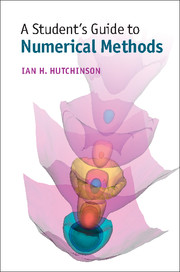Book contents
- Frontmatter
- Dedication
- Contents
- Preface
- 1 Fitting functions to data
- 2 Ordinary differential equations
- 3 Two-point boundary conditions
- 4 Partial differential equations
- 5 Diffusion. Parabolic partial differential equations
- 6 Elliptic problems and iterative matrix solution
- 7 Fluid dynamics and hyperbolic equations
- 8 Boltzmann's equation and its solution
- 9 Energy-resolved diffusive transport
- 10 Atomistic and particle-in-cell simulation
- 11 Monte Carlo techniques
- 12 Monte Carlo radiation transport
- 13 Next steps
- Appendix A Summary of matrix algebra
- References
- Index
13 - Next steps
Published online by Cambridge University Press: 05 May 2015
- Frontmatter
- Dedication
- Contents
- Preface
- 1 Fitting functions to data
- 2 Ordinary differential equations
- 3 Two-point boundary conditions
- 4 Partial differential equations
- 5 Diffusion. Parabolic partial differential equations
- 6 Elliptic problems and iterative matrix solution
- 7 Fluid dynamics and hyperbolic equations
- 8 Boltzmann's equation and its solution
- 9 Energy-resolved diffusive transport
- 10 Atomistic and particle-in-cell simulation
- 11 Monte Carlo techniques
- 12 Monte Carlo radiation transport
- 13 Next steps
- Appendix A Summary of matrix algebra
- References
- Index
Summary
This book is by deliberate choice an introduction to numerical methods for scientists and engineers that is concise. The idea is that brevity is the best way to grasp the big picture of computational approaches to problem solving. However, undoubtedly for some people the conciseness overstrains your background knowledge and requires an uncomfortably accelerated learning curve. If so, you may benefit by supplementing your reading with a more elementary text.
For readers who have survived thus far without much extra help, congratulations! If you've really made the material your own by doing the exercises, you have a wide-ranging essential understanding of the application of numerical methods to physical science and engineering. That knowledge includes some background derivations and some practical applications, and will serve you in good stead in a professional career. It might be all you need, but it is by no means comprehensive.
The conciseness has been achieved at the expense of omitting some topics that are without question important in certain applications. It is the purpose of this concluding chapter to give pointers, even more abbreviated than the preceding text, to some of these topics, and so open the doors for students who want to go further. Of course, all of this chapter is enrichment, and demands somewhat deeper thought in places. If for any topic you don't “get it” on a first reading, then don't be discouraged. References to detailed advanced textbooks are given.
Finite-element methods
We have so far omitted two increasingly important approaches to solving problems for complicated boundary geometries: unstructured meshes and finite elements. Unstructured meshes enable us to accommodate in a natural way boundaries that are virtually as complicated as we like. The reason they are generally linked with finite-element techniques is that the finite-elements approach offers a systematic way to discretize partial differential equations on unstructured meshes. By contrast, it is far more ambiguous how to implement consistently finite differences on an unstructured mesh.
- Type
- Chapter
- Information
- A Student's Guide to Numerical Methods , pp. 171 - 192Publisher: Cambridge University PressPrint publication year: 2015



